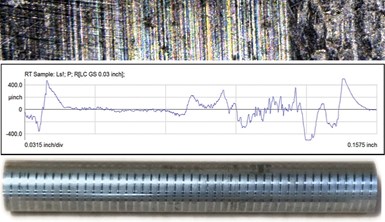Craftsman Cribsheet No. 114: Factors Influencing Machined Surface Finish in Our Shops
Surface finish is the result of our machining process on raw materials.

Photo Credit: Northlake Steel
There are three principal causes of surface roughness:
- the feed marks left by the tool on the work;
- fragments of built-up edge (BUE) pressed into the surface of the work by the tool during chip formation and removal;
- artifacts resulting from tool vibration and displacement on the workpiece. Efforts to reduce the height (depth) of the feed (tool marks), reduce the size of BUE and reducing vibration by improving rigidity will improve as machined surface finish.
Here are some of the various factors that can impact surface finishes produced by our machining processes.
Material Factors
High hardness, high strength and low ductility tend to be associated with good surface finish in steels. Lower carbon steels tend to be lower hardness and lower strength, more ductile and thus tend to leave a more torn surface finish. Higher carbon steels cut more crisply than low carbon grades, which are more suited for cold heading.
The strain hardening of hot-rolled steels by cold drawing has been shown to improve as machined surface finish.
In addition to mechanical properties and treatments, chemical composition can also contribute to improved machined surface finish — increasing carbon content improves surface finish compared to low carbon steels.
Free machining additives such as sulfur help to control built-up edge, resulting in improved finishes. Additions of phosphorus and nitrogen can help embrittle the chip, contributing to smoother finishes. Lead, selenium, tellurium and bismuth also help with chip separation, improving surface finish off the machine.
Machining Factors
While specifying chemistry remains out of our scope in most contract manufacturing, the machinist has several variables that are under their control.
Cutting speed has probably the largest potential to improve machined surface finish as anything else we can do in our shops. Increasing cutting speed greatly improves surface finish achieved. Increasing feed significantly reduces surface finish, so increasing speed while reducing feed is a likely path to improving surface finish in a new job.
Increasing rake angle also leads to significant improvement in surface finish. While many shops have moved from HSS tools of their own manufacturer to the use of premanufactured inserts, knowing what the angles do for surface finish can help you when trying to move to another insert to improve finish.
Increasing relief angle can reduce surface finish, while increasing side cutting edge angle is usually associated with improved surface finish. Increasing the end cutting edge angle can lead to large declines in surface finish.
Increasing the nose radius of the tool can improve surface finish, as long as the grade does not easily work harden. (Most nickel grades work harden). Increasing the nose radius of the tool reduces the depth or height of the tool ridges left by the tool. Larger nose radius also reduces the size of the chip as well as the BUE.
Tool materials, tool coatings, metalworking fluids and additives also have a role to play in improving machined surface finishes in our shops. However, the precision machinist has several options in their control: increasing speeds, reducing feeds, increasing angle of cut and increasing nose radius.
Related Content
Roles of Women in Manufacturing: What I Learned
Over 20 women were featured in the Roles of Women in Manufacturing series, which started in January 2023.
Read MoreCraftsman Cribsheet No. 128: Why Do Machinists Say Tenths Instead of Ten Thousandths?
In machinist parlance, a tenth is a tenth of a thousandth, not a tenth of an inch.
Read MoreKeeping It In The Family — Succession Tips From Those Who Lived It | Part 1
PMPA members share some tips to avoid getting burned when passing the business torch from one family member to another.
Read MoreOnshoring Weather Report: Strong Tailwinds!
Onshoring, reshoring, nearshoring: these terms are showing up with increasing frequency in the news and online. But is there evidence that these are real?
Read MoreRead Next
5 Aspects of PMTS I Appreciate
The three-day edition of the 2025 Precision Machining Technology Show kicks off at the start of April. I’ll be there, and here are some reasons why.
Read MoreA Tooling Workshop Worth a Visit
Marubeni Citizen-Cincom’s tooling and accessory workshop offers a chance to learn more about ancillary devices that can boost machining efficiency and capability.
Read MoreDo You Have Single Points of Failure?
Plans need to be in place before a catastrophic event occurs.
Read More





















